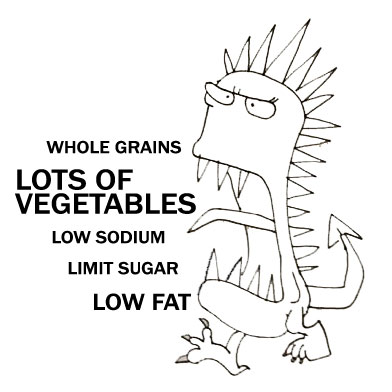“Don’t worry, he’ll grow out of it.”
More than frightened parents being placated by medical professionals, I can’t help sensing that there is something genuinely wrong with the whole world of eating in general. Perhaps it’s fueled by fears of being fat, or maybe it’s the growing mistrust, and frequent misuse of science. Are we too health conscious, size conscious, nutrition conscious? Maybe too hyper focused on insignificant details or trying to achieve the perfect diet? Whatever it is, most of the eating world seems to be missing the bigger picture.
Let me paint it for you, Hostage Monster style.
On one side of the eating spectrum is the science-based nutrition world of government dietary guidelines.
The dietary guidelines are suggestions for cardiovascular health and the prevention of obesity. It’s dietary advice that the majority of the population, for several reasons, have trouble following. In terms of eating more vegetables, for example, produce is expensive, or not available, or not of adequate quality, or doesn’t taste appealing. The relationship with food on this side of the eating spectrum is best described as complicated.
On the opposite side of the eating spectrum are the dietary puritans.

Basically, this side believes they shouldn’t need a science degree to go grocery shopping. There is a fairly healthy fear of chemistry on this side of the eating spectrum, supported by those with more marketing knowledge than science. Taken to extremes, trying to achieve dietary purity is a whole other kind of disordered eating known as orthorexia.
In the middle is the general public who are regularly exposed to science-based fact and fabricated opinion from both sides, plus a few other points of view from the diet industry, and the trendy health and body-shape catch phrases in the media.
This is a simplistic example. Add to this the realities of finding reasonably priced food that tastes good, items that are also convenient to purchase and easy to prepare. Now consider that average John and Jane Q Citizen have families, jobs, and lives that already come with their own deadlines, responsibilities, stresses, and concerns. It’s a lot of noise to filter through while figuring out what to have for dinner.
Lately, I’ve been thinking about the dynamic that feeds a parent’s sense of pathology in the face of feeding issues. When you have a child that struggles with eating, you get it from all sides of the eating spectrum, plus the opinion of everyone along the way, peppered with the advice of what worked for the neighbour, the boy at school, the kid on TV…
When I walked into the doctor’s office for professional perspective, this is what I brought with me. Fears for the current and future health of my child. Is he getting enough nutrition to support growth and development. Is he a healthy weight, will he be fat, will he starve to death? Will he be able to eat with friends, at school, in social settings? Will he be teased or bullied out of his self worth into a pit of depression and despair? Why won’t he eat? How can I get him to eat? What’s wrong with my child?
And this is when the doctor usually says something completely asinine like “Don’t worry, he’ll eat when he gets hungry.” Unfortunately, our family doctor knew very little about how to feed children, which did nothing to relieve my sense of pathology.
One in four children is reported to have some form of feeding disorder. Parents need support when they first ask for it, while their child is young. No child will grow out of anything unless the conditions that are causing the issue are changed. Once physical barriers to eating have been addressed, and pressure has been removed from the table, then, and only then, is there a chance for the child to grow into a healthier relationship with eating.
Feeding issues are complex and solving the problem requires addressing the child’s developmental ability, parental feeding style, medical issues, allergies and cultural attitudes.
It’s not about the food.
Special thanks to Louise at Busy Circle Photography for the Hostage Monsters.




Indeed. You know that I always, always, always say it’s not about the food…because it’s not.